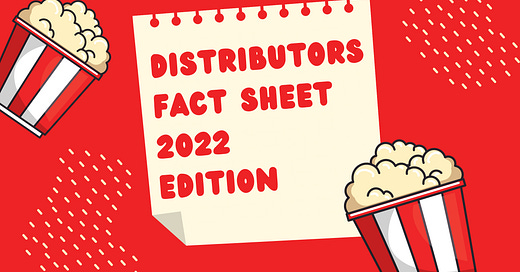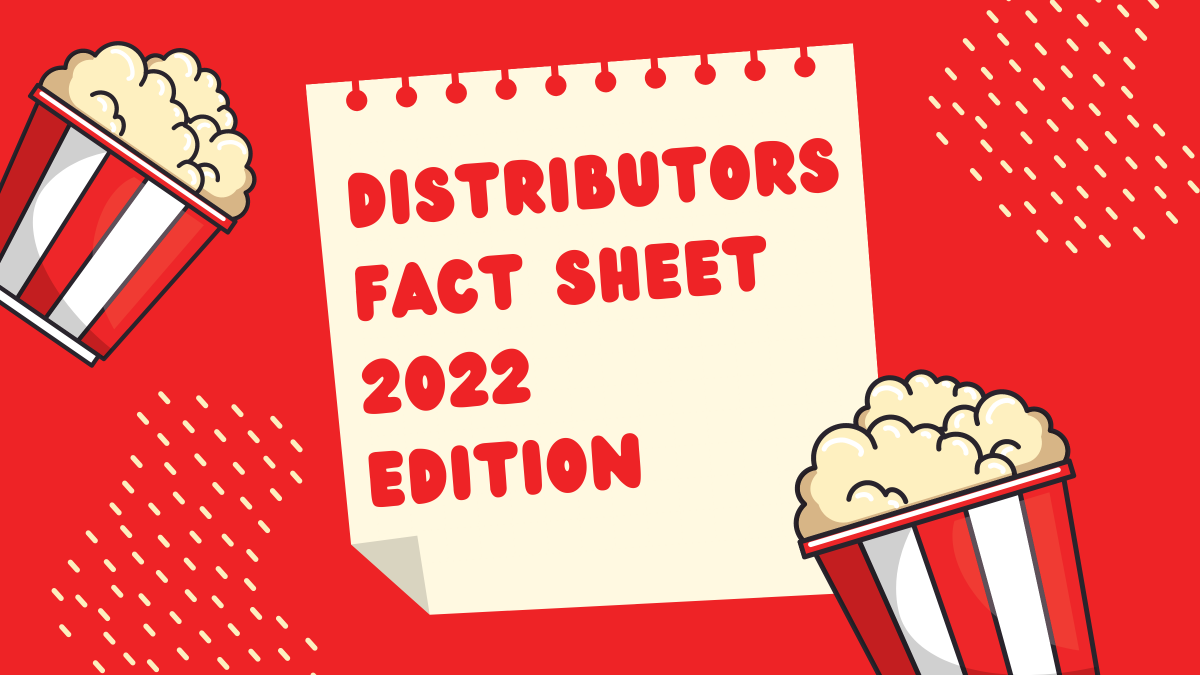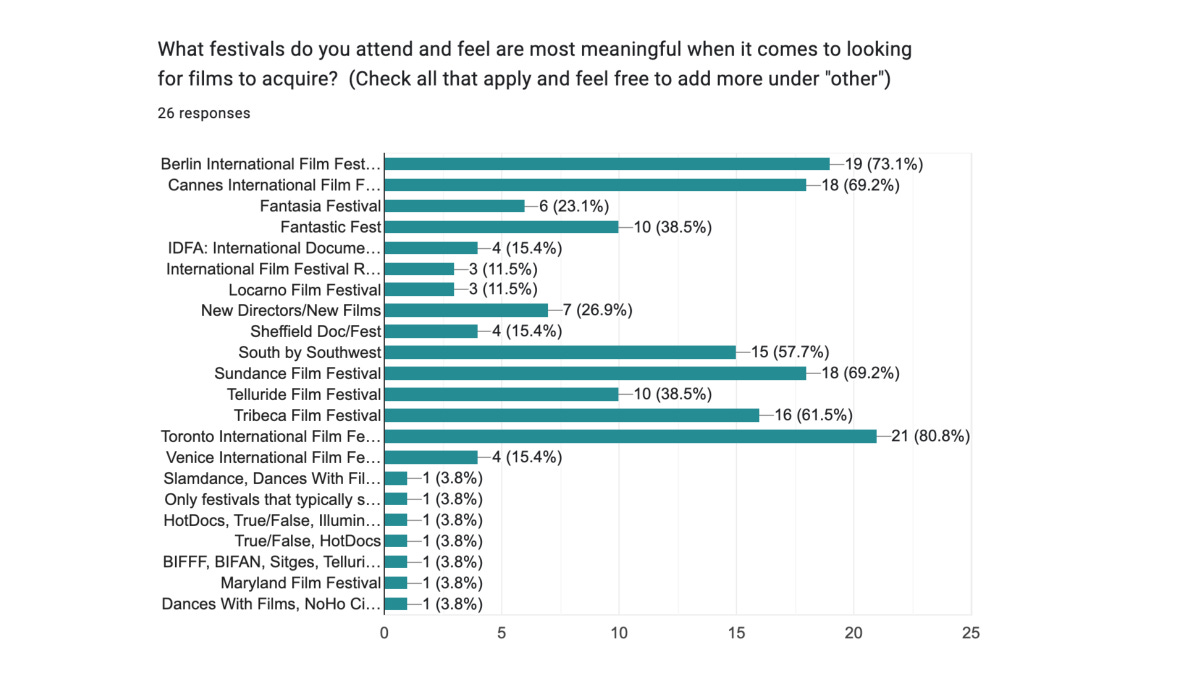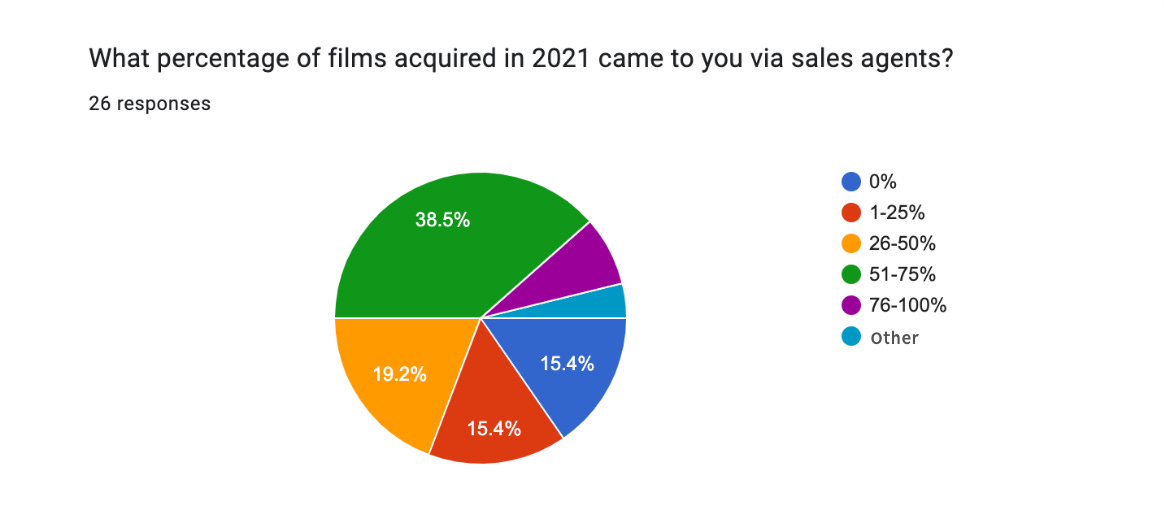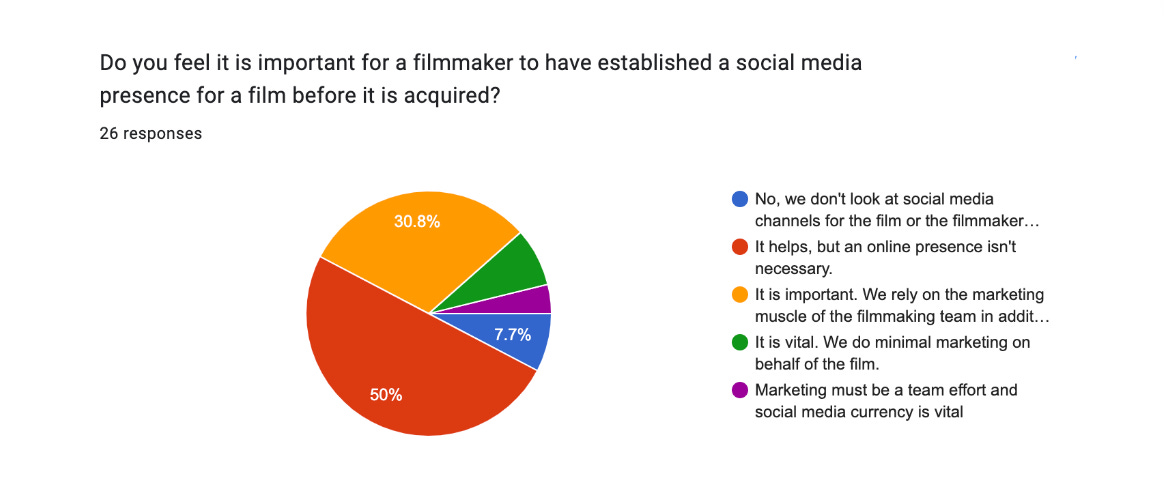For the third year in a row, Dear Producer brings you the Distributor Fact Sheet (See 2019 and 2021 Edition). We started this initiative to help demystify the distribution landscape for independent filmmakers. Countless labs exist to assist filmmakers in getting their film’s funded, yet resources remain scant to help those same films actually get in front of audiences. We hope to bridge the information gap by providing you a directory of distributors as well as their tenets; what do they look for, where do they look for it, and how are they acquiring the content. This year we extended our survey to include questions regarding the diversity of staff (age, race, gender, veteran status, abilities), the usage of sales agents in the acquisition process and the doling out of minimum guarantees.
Here are some key takeaways from the responses:
Lack of transparency from distributors continues.
We were surprised by the large drop off in participation this year after expanding our survey to include topics such as diversity and payouts of minimum guarantees (aka MG – the amount a distributor pays to license a film). This year we had just 26 companies respond compared to 38 last year, 2 of which did not disclose answers to questions regarding diversity, and 5 who chose not to disclose the average MG amount paid. One distributor put it quite bluntly, “This year you added a bunch of stuff I am not comfortable answering so I am passing this time.” Another distributor expressed, “This year, I am afraid there is just a bit too much red tape that is out of my control, so have to pass on the opportunity.”
In a market that is getting leaner than it already was, it seems there’s a concern on behalf of distributors that the wind will blow in an opposing direction if they share too much information. If distributors are feeling this scarcity mentality, what about the filmmakers? For years, filmmakers have handed over content of value only to get back very little in return. We cannot force the marketplace to yield more money for the art, but we can help filmmakers make informed decisions on what their distribution agreements might entail and encourage distributors to foster relationships by being transparent about how they work.
There were new additions to where distributors pick up films.
While the usual festival suspects were still represented, new additions popped up like Maryland Film Festival, NoHo Cinefest, Dances with FIlms and Illuminate. This provides a more optimistic view on the role festivals will continue to play in distribution moving forward, despite pandemic era doubts.
Diversity in distributor staff positions show room for improvement.
While we do not have the data of previous years to compare these percentages to, it will be helpful to see in subsequent reports how these numbers (hopefully) change for the better. Racial diversity clocked in with 15 of 26 companies reporting at least 15% of staff identifying as POC. Five of those companies reported 50% or more identifying as POC with the average percentage of 36% of staff members identifying as POC across all companies who responded to this question.
Women in staff positions had a stronger turnout with 17 of 26 companies reporting at least 20% identifying as female. 11 of those 17 companies reported 50% or more identifying as female with an average percentage of 48.8% of staff members identifying as female. With the 2020 US Census reporting 50.52% of all Americans identifying as female, this is one category where the larger population’s diversity is becoming more reflected inside these pivotal positions within our industry. The work is by no means done and other categories, as you’ll continue to read, have far more to go.
Representation of LGBTQIA+ among distribution staff clocked in at just 9 of 26 companies reporting at least 10% of staff identifying. Only one company reported having 50% of their staff composed of LGBTQIA+ identifying individuals.
Both the disabled and veteran categories had low turnouts with only 3 of 26 companies reporting at least 10% of staff identifying. Both categories had just one company reporting 50% of staff identifying as disabled or veteran.
Lastly, of those reporting, staff seems to skew over 40 years old as 15 of 26 companies reported having at least 10% of staff identifying as 40+. Of those companies, 8 reported 50% or more of their staff being 40+ with one company reporting 100% of their staff being over 40 years old.
A high percentage of companies do not pay Minimum Guarantees.
Of the 21 companies that responded to this question, 9 (34.6%) said they paid no minimum guarantee. 6 companies (23.1%) paid between $10,001 – $50,000 and 4 companies (15.4%) paid just $1 – $10,000. Only 1 company reported paying $10,000-$100,000 and 1 company $50,001 – $150,000. While getting an MG may not be a filmmaker’s singular deciding factor for choosing to go with a particular distributor, knowing these numbers certainly add to making an informed decision when deciding how to budget your film and setting expectations with financing partners.
A lot of films were acquired in 2021.
Aside from Box Office Mojo, which does not report on every film or distributor, there is no place to go to find out how many films are released each year. While the data we collected on how many films each distributor acquired in 2021 is not exact (based on how we asked the question in number ranges) the 26 distributors who participated reported acquiring a combined 600+ films in 2021. That’s a lot of films especially since it does not include the films acquired from the 30+ companies we reached out to that did not participate in this survey (see list at the end of this article). Though as the data shows above, 100% of those films were acquired for less than 150k.
Words and reality seem to mismatch when it comes to needing a sales agent.
At first glance it looks promising to see 15 of 26 companies encourage filmmakers to submit their films either through their website or emailed directly, as opposed to requiring a sales agent. While it’s good to know that more distributors are open to receiving submissions directly, when asked, “What percentage of films acquired in 2021 came to you via sales agents?” the data told a different story. Some companies, 15.4% of them, did in fact acquire all of their films without a sales agent. Another 15.4% however used a sales agent for up to a quarter of all of their films while 19.2% used one for up to half of all of their films. Then the real kicker comes, a whopping 38.5%, the largest grouping, said up to 75% of all of their films came through a sales agent. This signifies that while you may not need a sales agent necessarily to get your foot in the door, your odds of getting a deal still largely hinge on having one.
Distributors remain clueless about social media.
Despite TikTok having 1billion active users around the globe, 50% of distributors responded saying an it isn’t necessary for a filmmaker to have an online presence. When we wonder why audiences aren’t showing up to indie films, perhaps we should consider the simple fact that they don’t know about them.
Final thoughts…
We’d like to encourage all distributors reading these fact sheets to think of this as an opportunity to draw a line in the sand for how your distribution company is different, how it communicates with filmmakers, how it better connects artists to audiences and how it maintains the value of the content in a way that creates a more sustainable, and equitable, future for us all.
Now to get to the questions, here is what we asked everyone:
Please provide a short description of your company, including what year the company was founded.
List a few of your company’s most recent releases or acquisitions.
What is the size of your company? (If more than just a distribution company, please select only the number of distribution employees.)
What type of content do you primarily acquire?
What rights do you typically acquire?
What is your average license term length?
What festivals do you attend and feel are most meaningful when it comes to looking for films to acquire? (Check all that apply and feel free to add more under “other”)
Do you feel it is important for a filmmaker to have established a social media presence for a film before it is acquired?
How many films did you acquire in 2021?
What percentage of films acquired in 2021 came to you via sales agents?
What percentage of films acquired in 2021 were paid minimum guarantees/advances?
What was the average minimum guarantee/advance paid to films acquired in 2021?
What percentage (%) of your distribution staff (paid or unpaid) is made up of people identifying as people of color?
What percentage (%) of your distribution staff (paid or unpaid) is made up of people identifying as women?
What percentage (%) of your distribution staff (paid or unpaid) is made up of people identifying as LGBTQIA+?
What percentage (%) of your distribution staff (paid or unpaid) is made up of people who identify as disabled?
What percentage (%) of your distribution staff (paid or unpaid) is made up of people identifying as veterans?
What percentage (%) of your distribution staff (paid or unpaid) is made up of people over the age of 40?
How many films do anticipate acquiring in 2022?
What is the best way for a filmmaker to submit their film to you for consideration?
Share your thoughts about the future of independent film here:
What do you wish filmmakers better understood about distribution?
Is there anything else you’d like us to know about your company?
Go to Dear Producer to see the full responses…
For consulting services, email: liz.manashil@gmail.com
If you are enjoying and benefiting from the stories we are publishing, please consider making a donation to ensure that we can continue to provide free resources for filmmakers and amplify the voices of producers.


